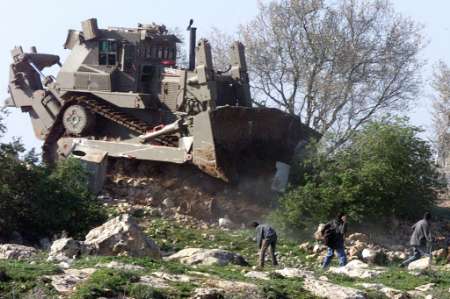Jesse Rosenfeld writing from Ramallah, Occupied West Bank, The Electronic Intifada, 5.11.07. Karni has traditionally been a major goods crossing for Gaza, but hitchhiking in the car of an Associated Press journalist we are stopped by military jeeps two kilometers before the crossing and told that it is closed. We get out of the car and walk back towards a dusty lot three kilometers away where 10 trucks are resting. The only vehicles heading in the direction of Karni are a few cars taking the exit road for the nearby kibbutz, military vehicles, and fuel trucks going to the military base 500 meters from where we were stopped. "We take chickens and cows in, nothing comes out," a truck driver says. "We take our cargo to the crossing and Palestinians pick it up on the other side. Only food gets through." He says that Karni is a livestock crossing and that only Israeli drivers can deliver cargo. When the truck gets near the crossing the cargo is dumped, checked by the military and put on a track over to Gaza. However, no livestock trucks are leaving for the crossing. In an e-mail correspondence with the Atfaluna Society for Deaf Children in Gaza, they inform me that their hearing aids and hearing aid batteries have been blocked by the military since June. The organization provides hearing aids, hearing aid equipment and schooling for deaf children in Gaza. We get picked up on the side of the road by an Israeli woman who has lived in the area since 1979. She says she's not busy and kindly offers to drive us to both of the crossings. Despite only living kilometers from the Gaza crossing she seems oblivious to the impact of the blockade on Gaza and the severe shortages people are experiencing. ufa is supposed to be the new major crossing which Israel claims is seeing between 100 and 120 trucks daily. However, the crossing looks more like a giant sand pit filled with tanks and there's a military base in the distance. The road running through the sand comes to an abrupt end with three large cement cubes blocking further travel, but before we even get there the soldiers call out from their parked tank to stop. Perplexedly they jump out and jog towards the car, machine guns at their side, and after a short conversation in Hebrew with the driver they tell us in English that we can't go any further. There isn't a transport truck in sight, despite this supposedly being the new main goods transport route, and even if there were it is impossible to see how the trucks would proceed through the cement blocks towards Gaza. Gaza hospitals were reporting to have run out anasthetics just two days before. By 6 October the Palestinian Medical Relief Society was warning of a pending health crisis because the blockade was making it extremely difficult to administer medical attention. At the time, they reported that people receiving kidney dialysis three times weekly had their treatment cut to twice weekly because of equipment shortages. Kerem Shalom is a central three-way border for goods between Israel, Gaza and Egypt, and like the other two crossings it's completely deserted apart from sniper and watchtowers. It's 5:00pm and the only trucks we see are Israeli trucks using the crossing area as a shortcut to transport goods from local Israeli farms to other parts of Israel. The only thing that is definitely getting into Gaza is 20-year-old kids, armed to the teeth, crossing the border at night, and Israel wants to keep this too as quiet as possible.
Jesse Rosenfeld is a freelance journalist based in Ramallah. This article was originally published by Palestine Monitor and is republished with permission. All photos by Palestine Monitor.
Iscriviti a:
Commenti sul post (Atom)

Nessun commento:
Posta un commento